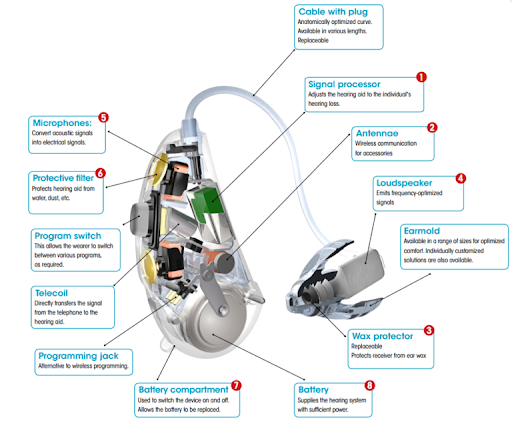
Receiver-in-canal hearing aids (RIC)
RIC hearing aids are known for their versatility and suitable for various degrees of hearing loss. Learn more or book an appointment today.
What is a receiver-in-canal hearing aid (RIC)?
If you’re experiencing signs of hearing loss, Bay Audio can help. Whether you’re struggling to hear soft sounds, or background noise is affecting your ability to hear conversations, our team can provide advanced hearing solutions.
Receiver-in-canal hearing aids (RIC) are custom-made devices that sit behind the ear and deliver sound to the eardrum. While some hearing aids create a seal within the ear, RICs are open-ear devices that allow for a natural flow of air and sound, while providing crisp and clear amplification. With a small profile, RIC hearing aids are more discreet than behind-the-ear (BTE) devices and are suitable for all levels of hearing loss.


How do receiver-in-canal hearing aids (RIC) work?
Receiver-in-canal hearing aids (RIC) sit behind the ear and collect sound with small but powerful multi-directional microphones. Digital processors pass the sound in real time to a receiver via a tiny wire. The receiver (a speaker) is a soft tip or dome that sits inside the ear canal and amplifies the sound close to the eardrum for excellent sound quality.
Features of receiver-in-canal (RIC) hearing aids
- Lightweight and comfortable. Experience all-day comfort no matter your level of hearing loss.
- Personalised settings and customisable programming. Optimise your hearing in various environments, whether you’re talking in a busy setting or navigating loud environments.
- Clearer speech clarity, and no feedback. Slip seamlessly into conversation thanks to the RIC receiver’s position close to the eardrum where it creates clear listening.
- More discreet than traditional behind-the-ear (BTE) devices. Enjoy optimal listening without compromising on style.
Seamless wireless connectivity. Because RITCs are positioned outside the ear, they allow excellent Bluetooth connectivity to smartphones, TVs and other devices.


Receiver-in-canal hearing aids (RIC) at Bay Audio
Livio Edge AI
Livio Edge AI receiver-in-canal hearing aids deliver next generation performance with crisp, clear sound and premium smart features. Experience clarity in even the most challenging listening environments and take charge of more than just your hearing. With Livio Edge AI, you can track your physical and mental activity, monitor for falls, and even ask your AI personal assistant to check the weather.
Muse iQ
The Muse iQ is a premium receiver-in-canal hearing aid, equipped with Acuity Directional and Speech Shift features for immersive 360-degree sound. It easily adapts to new sounds in challenging listening environments, so you don’t miss a beat of conversation. Engineered to address diverse levels of hearing loss, the Muse iQ also incorporates Multiflex Tinnitus Technology to offer relief from tinnitus symptoms.
Pros and cons of receiver-in-canal (RIC) hearing aids
Advantages of receiver-in-canal hearing aids:
- Open-ear design prevents the ‘plugged up’ feeling from in-the-ear devices
- Minimises the sounds of your own voice
- Discreetly positioned behind the ear
- Near-invisible wiring
- Receiver is placed in the canal for unbeatable sound quality
- Some models offer rechargeable batteries
Cons of RICs:
- The receiver is vulnerable to wax and moisture
- Easier to misplace than other devices due to lightweight and discreet design

Book An Appointment Today
If you are experiencing signs of hearing loss, our expert team of audiologists is available to answer any questions you might have.
Frequently Asked Questions
The main difference between behind-the-ear vs receiver-in-canal hearing aids is how sound is delivered to the ear canal, and where the receiver sits in proximity to the eardrum.
Engineering: Both BTEs and RICs are encased in a hard shell that sits behind the ear, and contains electronic components including microphones, an amplifier, and digital features. BTE speakers are inside the casing and deliver sound via a small, plastic tube. RICs deliver audio data to speakers that sit in the ear canal via a micro wire.
Design: Receiver-in-canal hearing aids are smaller than BTEs, making them discreet and lightweight.
Sound quality: Because RIC speakers are positioned deeper in the ear than BTEs, sound quality is better and feedback is minimised.
Receiver-in-canal hearing aids (RIC) are sensitive to moisture and wax exposure. Clean your devices regularly for maximum clarity of sound and device longevity.
Inspect the dome or tip every day and gently wipe the surface with a soft cloth. Contact your audiologist if you notice any cracks, splits or cracks.
If your hearing aid receivers have domes, remove them every week and clean with a warm, soapy cloth. If your hearing aid has earmounds, don’t attempt to remove these. Instead, wipe with a damp cloth, but stay away from the tip.
Replace the wax traps and brush all areas of the device regularly, including microphones and air vents. For the best quality of care, have your hearing aids serviced at least every 6 months.
Receiver-in-canal hearing aids prices are influenced by the brand, model and the types of technology features included in the device. The dedicated team at Bay Audio can offer you the best options for your budget, preferences and level of hearing loss. Book an appointment today for expert advice that’s tailored to your needs.
